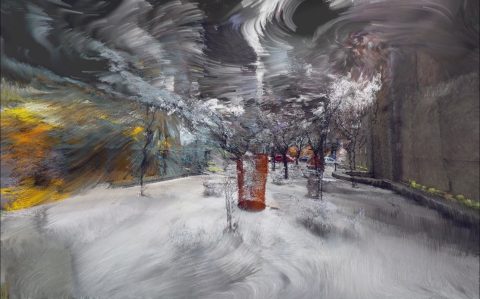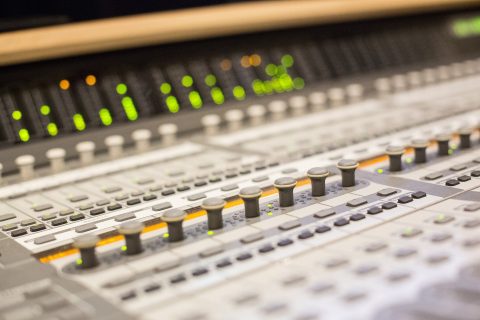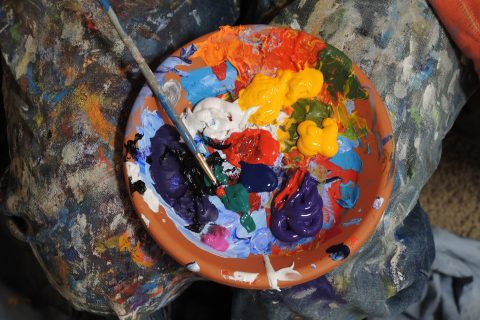Intermedia (Video, Performance and Electronic Arts) (BFA)
Why study Intermedia?
Play with technology. Take it apart. Understand it. Then use it to invent new combinations of artistic content, practice, and presentation across electronic, video or performance media. If you want to explore relationships between emerging and existing media technologies and the fine arts, then this program is for you.
You decide how to combine your study: video art, performance art, robotics, sound art and immersive environments, or just focus on one or two of these streams. Learn programming and digital technologies to create new artistic experiences. Or pull concepts from dance, theatre, or even sculpture, and use your own body as medium into performance art.
Above all, experiment, be curious, and explore. Our chroma-key studio, video editing suites and selection of equipment are impressive and will support your practice.
Program highlights
- Access to state-of-the art production facilities for video, sound, digital, robotic, and performance creations
- Students can borrow from a depot of equipment including sound recording gear, lights, projectors, rasberry pis, arduinos, sensors, and more
Special funding for out-of-province students
Up to $4000 for undergraduate programs.
Program structure
A Bachelor of Fine Arts degree takes a minimum of three or four years (90 – 120 credits) of full-time study, depending on your academic background.
Program option
- Major in Intermedia (Video, Performance, and Electronic Arts) (60 credits)
Combine studies in media arts, new technologies and interdisciplinary practices with a major in Intermedia. Imagine a learning environment where you can study electronic arts, video, performance art, immersive environments and sound art production. The Intermedia program addresses the creative interests of student artists who want to explore the interdisciplinary relationships between emerging, new and existing media technologies and traditional visual arts. Intermedia encourages dialogue between traditional disciplines and new forms of artistic expression using technology and integrated media with a focus on electronic arts, video art and performance art.
Courses
Admission criteria
This program is available for Fall admission only.
Minimum cut-off averages and course requirements
- Quebec CEGEP: DEC
- High School: C+
- ACT or SAT is NOT required
- Canadian curricula course requirements
- Accepted international qualifications
- International Baccalaureate (IB) diploma: 26
- International Baccalaureate Career-related Programme (CP): 4.3/7
- Baccalauréat français: 11
- British system of education (GCE):
- A-levels: At least two A-level exams CD or
- AS-levels: At least 4 AS-level exams with equivalent results or
- BTEC: Level 3 Diploma or Extended Diploma in a related subject area with equivalent results
- Additional information for British System of Education (GCE) applicants
- University Transfers (internal/external): C
Additional requirements for admission
Applicants must submit additional requirements for admission directly to the department.
Intermedia portfolio
Your work
- Please include a minimum of 15 examples of your work that demonstrate your interests and explorations in video art, electronic arts and performance art.
- You may include photographs, animation, film, video or audio recordings.
- Documentation of performance art, video or electronic art installations is also encouraged.
- Ensure your submissions are well organized and easy to navigate.
Letter of intent
Your letter of intent should be no longer than one page, written in English or French, and address the following:
- Why have you chosen Intermedia? Describe your understanding of the program and list the particular media and disciplines you would like to study.
- Describe your academic and artistic background.
- What are your particular goals in relation to Intermedia?
Minimum cut-off averages should be used as indicators. The cut-off data may change depending on the applicant pool. Applicants who meet the stated minimum requirements are not guaranteed admission to these programs.
Application deadlines

FALL ENTRY (September)
Deadline: March 1
U.S. and international applicants: Apply no later than February 1 to allow time for immigration document processing. However, applying earlier is strongly recommended. Immigration processing times vary by country, and delays could prevent you from starting your studies on time.

WINTER ENTRY (January)
Admission to this program is available for the Fall Term only.
We reserve the right to close admission to a program at any time after the official deadline without prior notice.
Funding note
Quebec residents who enroll in certain programs and meet the eligibility criteria may apply for funding of $2,500 per term through the Quebec Perspective Bursary (Bourse Perspective Quebec).
United States students: A U.S. Federal Student Aid-eligible version of this program is offered. This version meets all U.S. regulations (such as no co-operative education or e-courses) for eligible programs.
After your degree
You will graduate with the knowledge and discipline required for a creative and productive life. You’ll have creative problem-solving skills, know how to think critically about your work, and have the necessary leadership skills required for entrepreneurial endeavours. Your degree can lead to many paths such as:
- Creative or art director
- Performance artist
- Research and graduate studies
- Video editor
Student story

Dougy Hérard
Major in Intermedia (Video, Performance and Electronic Arts) Minor in Game Design
Studio Arts is very action-based, you’re always creating.

Chloe Marchal
Honours in Anthropology
Major in Intermedia (Video, Performance and Electronic Arts)
Concordia is good at giving you opportunities for non-traditional learning that’s not just being in the classroom.
Other programs of interest

Find your place in the ever-changing landscape of digital arts. Discovering the creative potential of fundamental and emerging technologies.
Department
Department of Design and Computation Arts
Faculty

As an electroacoustic artist, your ear is your instrument. As a student, you will explore the possibilities for sonic creativity through electroacoustic composition, sound design and recording, while training your inner and outer ears.
Department
Faculty

As a Studio Art major, you’ll have the flexibility to choose a concentration or combine any of our seven disciplines: Ceramics, Fibres and Material Practices, Intermedia/Cyberarts (Performance, Video, Electronic Arts), Painting and Drawing, Photography, Print Media, Sculpture and Installation.
Department
Faculty

